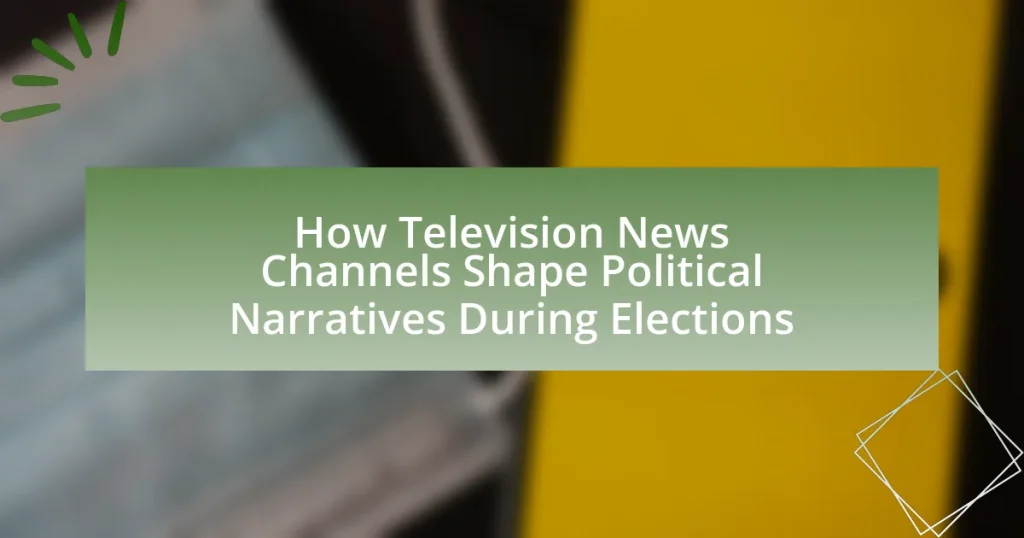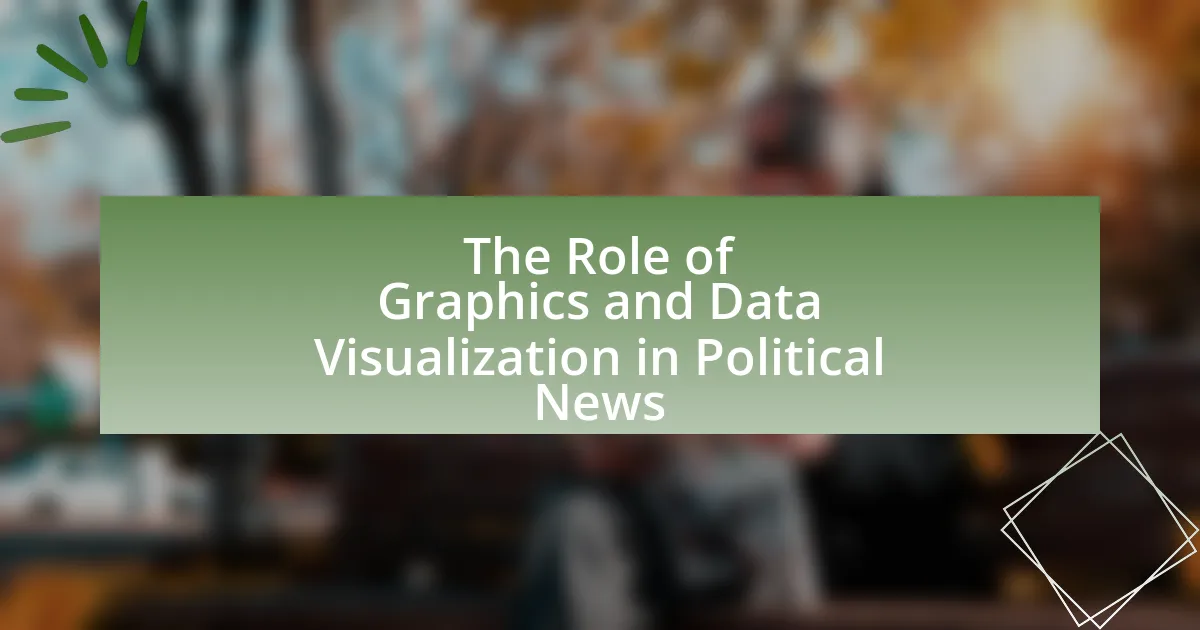Television news channels play a critical role in shaping political narratives during elections by influencing public perception through selective coverage, framing of issues, and candidate portrayal. Research indicates that the way news is presented can significantly affect voter opinions and behaviors, with factors such as story selection, timing, and emotional appeal impacting electoral outcomes. The article explores how news channels address bias, maintain viewer engagement, and the interplay between television news and social media, while also providing strategies for viewers to critically evaluate news content and enhance media literacy. Key historical examples illustrate the profound effects of news narratives on voter behavior and election results.
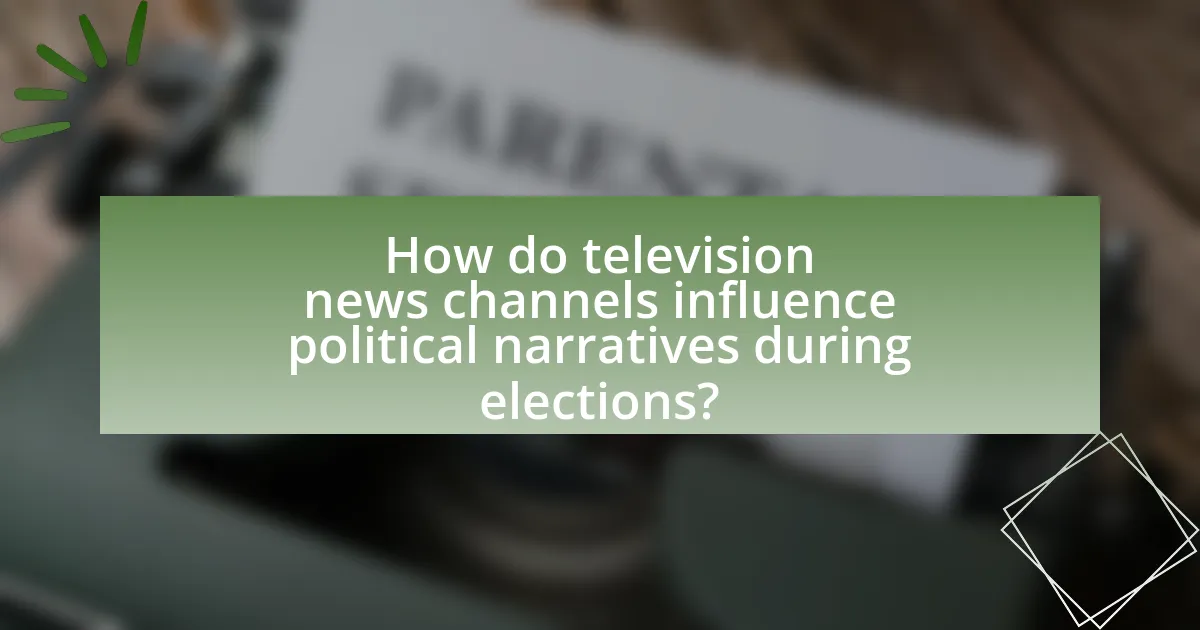
How do television news channels influence political narratives during elections?
Television news channels influence political narratives during elections by shaping public perception through selective coverage, framing of issues, and the portrayal of candidates. Research indicates that the way news outlets prioritize stories can significantly affect voter opinions; for instance, a study by the Pew Research Center found that 62% of Americans believe news coverage influences their views on political candidates. Additionally, the framing of issues—such as economic policies or social justice—can lead to different interpretations among viewers, ultimately guiding their electoral choices. The portrayal of candidates, including the emphasis on certain traits or controversies, further impacts how voters perceive their viability and trustworthiness.
What role do television news channels play in shaping public perception of candidates?
Television news channels significantly influence public perception of candidates by framing narratives, highlighting specific issues, and providing commentary that shapes audience opinions. Research indicates that the way news outlets present candidates—through tone, selection of stories, and emphasis on particular attributes—can lead to biased perceptions. For example, a study by the Pew Research Center found that viewers of partisan news channels often develop polarized views of candidates based on the channels’ framing. This framing can affect voter behavior, as candidates portrayed positively are more likely to gain support, while negative portrayals can diminish public favor.
How do news channels select which stories to cover during elections?
News channels select stories to cover during elections based on factors such as audience interest, relevance to the electoral process, and the potential impact on public opinion. They analyze polling data, social media trends, and viewer demographics to identify which topics resonate most with their audience. For instance, a study by the Pew Research Center found that 62% of Americans believe that news coverage influences their voting decisions, highlighting the importance of selecting impactful stories. Additionally, news channels prioritize stories that feature key candidates, major policy issues, and significant events, ensuring that their coverage aligns with the interests and concerns of voters.
What impact does the framing of news stories have on voter opinions?
The framing of news stories significantly influences voter opinions by shaping perceptions and interpretations of political events. Research indicates that the way news is presented—through language, imagery, and context—can alter public understanding and emotional responses. For instance, a study by Iyengar and Kinder (1987) demonstrated that different frames in news coverage led to varying levels of concern among viewers regarding specific issues, ultimately affecting their voting behavior. This suggests that news framing not only informs but also persuades voters, highlighting the critical role of media in shaping electoral outcomes.
Why is the timing of news coverage important in elections?
The timing of news coverage is crucial in elections because it influences voter perception and decision-making. Timely news can shape the narrative around candidates and issues, impacting public opinion just before voters cast their ballots. For instance, studies have shown that news coverage immediately preceding an election can significantly sway undecided voters, as they often rely on the latest information to make their choices. Additionally, the release of breaking news or major events can overshadow other campaign messages, altering the electoral landscape. This dynamic underscores the power of media timing in shaping political outcomes.
How does breaking news affect the political landscape?
Breaking news significantly influences the political landscape by shaping public perception and altering the agenda of political discourse. When major events occur, such as scandals or crises, they often dominate media coverage, leading to shifts in voter priorities and opinions. For instance, during the Watergate scandal, continuous breaking news coverage shifted public trust away from the Nixon administration, ultimately contributing to his resignation. This demonstrates how immediate news can create urgency and reshape political narratives, impacting election outcomes and policy discussions.
What strategies do channels use to maintain viewer engagement during election cycles?
Channels maintain viewer engagement during election cycles by utilizing interactive content, real-time updates, and targeted messaging. Interactive content, such as polls and social media integration, encourages audience participation and fosters a sense of community. Real-time updates on election developments keep viewers informed and invested in the unfolding events. Targeted messaging, tailored to specific demographics, enhances relevance and connection, ensuring that content resonates with diverse audience segments. These strategies are supported by research indicating that engagement metrics, such as viewer retention and social media interaction, significantly increase during election periods, demonstrating their effectiveness in capturing and maintaining audience interest.
How do television news channels address bias in political reporting?
Television news channels address bias in political reporting by implementing editorial guidelines that promote balanced coverage and by employing fact-checking mechanisms. These channels often establish standards that require presenting multiple viewpoints on political issues, thereby reducing the likelihood of one-sided narratives. For instance, the American Press Institute emphasizes the importance of transparency in reporting, which includes disclosing potential conflicts of interest and providing context for political stories. Additionally, many news organizations utilize independent fact-checkers to verify claims made by political figures, which helps to maintain credibility and accountability in their reporting.
What measures are taken to ensure balanced coverage of candidates?
Television news channels implement several measures to ensure balanced coverage of candidates, including adherence to journalistic standards, equal airtime policies, and diverse sourcing. Journalistic standards require that news outlets present multiple viewpoints and fact-check information to avoid bias. Equal airtime policies mandate that all candidates receive similar opportunities for exposure, which helps to level the playing field. Additionally, channels often utilize diverse sourcing by including opinions from various political analysts and experts, which contributes to a more comprehensive representation of the electoral landscape. These practices are essential for maintaining credibility and fostering informed public discourse during elections.
How do viewers perceive bias in election reporting?
Viewers perceive bias in election reporting primarily through the selection of stories, framing of issues, and tone of coverage. Research indicates that audiences often identify bias when they notice a disproportionate focus on certain candidates or viewpoints, which can lead to perceptions of favoritism or unfairness. For instance, a study by the Pew Research Center found that 62% of Americans believe news organizations favor one side in their coverage of political issues. This perception is further influenced by the language used in reporting, where emotionally charged words can sway viewer opinions about the impartiality of the coverage.
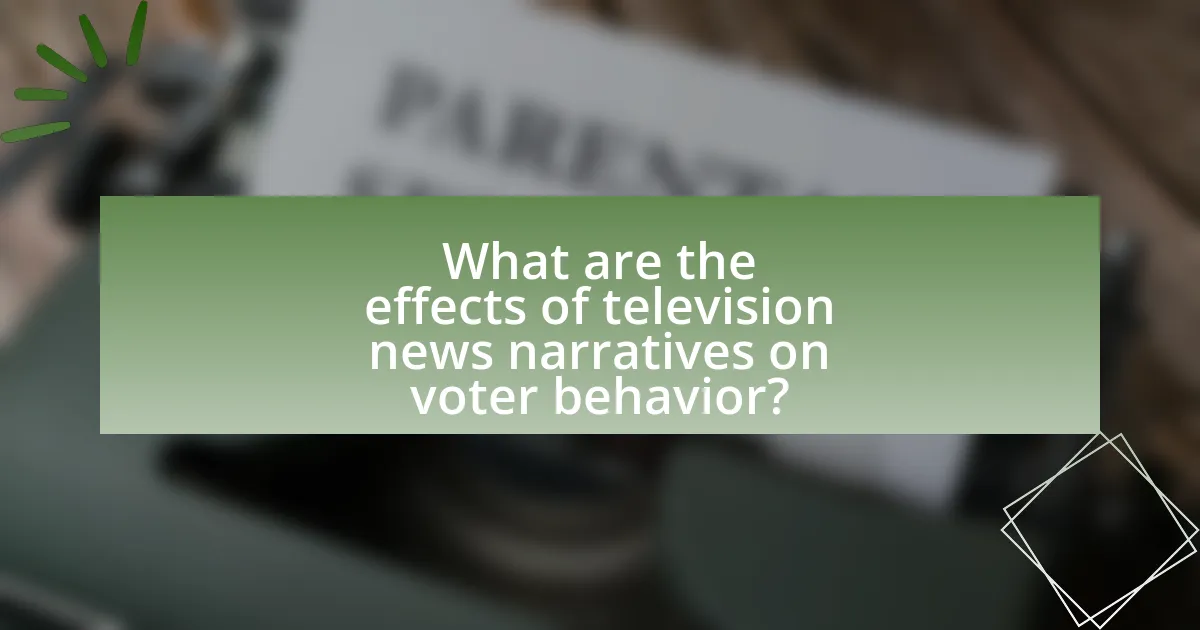
What are the effects of television news narratives on voter behavior?
Television news narratives significantly influence voter behavior by shaping perceptions of candidates and issues. Research indicates that the framing of news stories can affect public opinion, as voters often rely on these narratives to form their political views. For instance, a study by the Pew Research Center found that voters exposed to positive coverage of a candidate were more likely to support that candidate, while negative coverage led to decreased support. Additionally, the way issues are presented—such as emphasizing certain aspects over others—can sway voter priorities and decision-making processes. This demonstrates that television news narratives play a crucial role in guiding voter behavior during elections.
How do news narratives influence voter turnout?
News narratives significantly influence voter turnout by shaping public perception and engagement with political issues. When news outlets emphasize certain narratives, such as the importance of participation or the competitiveness of a race, they can motivate individuals to vote. For instance, studies have shown that when media coverage highlights high-stakes elections or portrays a close race, voter turnout can increase by as much as 5-10%. This effect is particularly pronounced among younger voters and those who may feel disenfranchised. Additionally, narratives that frame voting as a civic duty or a means of effecting change can further enhance turnout, as they resonate with individuals’ sense of responsibility and agency in the democratic process.
What role does emotional appeal play in news coverage?
Emotional appeal plays a significant role in news coverage by influencing audience engagement and shaping perceptions. News outlets often utilize emotional narratives to evoke feelings such as empathy, anger, or fear, which can lead to increased viewer retention and response. For instance, studies have shown that emotionally charged stories are more likely to be shared on social media, amplifying their reach and impact. This strategy is particularly evident during elections, where news coverage can sway public opinion by framing candidates and issues in emotionally resonant ways, ultimately affecting voter behavior and electoral outcomes.
How do narratives shape the decision-making process of voters?
Narratives significantly shape the decision-making process of voters by influencing their perceptions and emotional responses to political issues and candidates. Through storytelling techniques, television news channels create compelling narratives that frame political events, often highlighting specific aspects while downplaying others. For instance, research by the Pew Research Center indicates that voters are more likely to remember and be swayed by emotionally charged stories rather than dry statistics, which can lead to biased decision-making. Additionally, narratives can establish social norms and collective identities, as seen in the 2016 U.S. presidential election, where media narratives around candidates shaped public opinion and voter turnout. Thus, the way narratives are constructed and presented in news media plays a crucial role in guiding voter choices and shaping electoral outcomes.
What is the relationship between news coverage and election outcomes?
News coverage significantly influences election outcomes by shaping public perception and voter behavior. Extensive and favorable coverage of a candidate can enhance their visibility and appeal, leading to increased support, as evidenced by studies showing that candidates receiving more positive media attention often experience higher polling numbers. For instance, research conducted by the Pew Research Center indicates that candidates who dominate news cycles tend to gain a substantial advantage in voter recognition and preference. Additionally, the framing of issues and candidates in news reports can sway public opinion, as demonstrated in the 2008 U.S. presidential election, where media narratives played a crucial role in shaping perceptions of Barack Obama and John McCain. Thus, the relationship between news coverage and election outcomes is characterized by the media’s power to influence voter attitudes and decisions.
How can shifts in coverage impact polling results?
Shifts in coverage can significantly impact polling results by altering public perception and influencing voter behavior. When media outlets change the focus of their reporting, such as emphasizing certain candidates or issues, it can lead to changes in how the electorate views those candidates or issues. For instance, a study by the Pew Research Center found that increased media coverage of a candidate often correlates with a rise in their polling numbers, as voters become more familiar with them and their platforms. Conversely, negative coverage can diminish a candidate’s support, as seen in various elections where scandals or unfavorable reporting led to declines in approval ratings. Thus, the nature and direction of media coverage directly shape the political landscape and voter sentiment, ultimately affecting polling outcomes.
What historical examples illustrate this relationship?
Television news channels have significantly shaped political narratives during elections, as illustrated by the 1960 U.S. presidential debate between John F. Kennedy and Richard Nixon. This debate marked the first time candidates faced each other on television, influencing public perception based on their televised appearances. Kennedy’s confident demeanor contrasted with Nixon’s less polished presentation, leading to a shift in voter sentiment that favored Kennedy.
Another example is the coverage of the 2000 U.S. presidential election, where the role of networks in projecting election results and the subsequent recount in Florida highlighted the impact of media narratives on public understanding and political outcomes. The early call for George W. Bush by networks created confusion and affected voter confidence in the electoral process.
These instances demonstrate how television news channels can frame political narratives, affecting voter perceptions and decisions during elections.
How do social media and television news interact during elections?
Social media and television news interact during elections by amplifying each other’s reach and influence on public opinion. Television news often reports on trending topics and narratives that emerge on social media platforms, which can shape the coverage and framing of political events. For instance, during the 2020 U.S. presidential election, major television networks frequently referenced viral social media posts, thereby legitimizing and disseminating those narratives to a broader audience. This interaction creates a feedback loop where social media can drive news stories, while television news can validate and popularize social media discourse, ultimately influencing voter perceptions and behaviors.
What role does social media play in amplifying television news narratives?
Social media significantly amplifies television news narratives by providing a platform for immediate dissemination and engagement. This amplification occurs as television news segments are shared, discussed, and commented on across various social media platforms, increasing their reach and visibility. For instance, a study by the Pew Research Center found that 62% of adults in the U.S. get news from social media, which highlights how these platforms serve as a critical channel for news consumption and discussion. Additionally, social media allows for real-time audience interaction, enabling viewers to react to and share news stories instantly, further enhancing the narrative’s impact and shaping public perception during elections.
How do viewers engage with news content across different platforms?
Viewers engage with news content across different platforms through various methods such as reading articles, watching videos, sharing content on social media, and participating in discussions. For instance, a study by the Pew Research Center found that 53% of U.S. adults often get news from social media, highlighting the significant role of platforms like Facebook and Twitter in news consumption. Additionally, viewers tend to prefer video content, with 86% of online news consumers indicating they watch news videos, which emphasizes the importance of visual storytelling in engaging audiences. This multi-platform engagement reflects a shift in how news is consumed, with viewers actively seeking diverse formats and channels to stay informed.
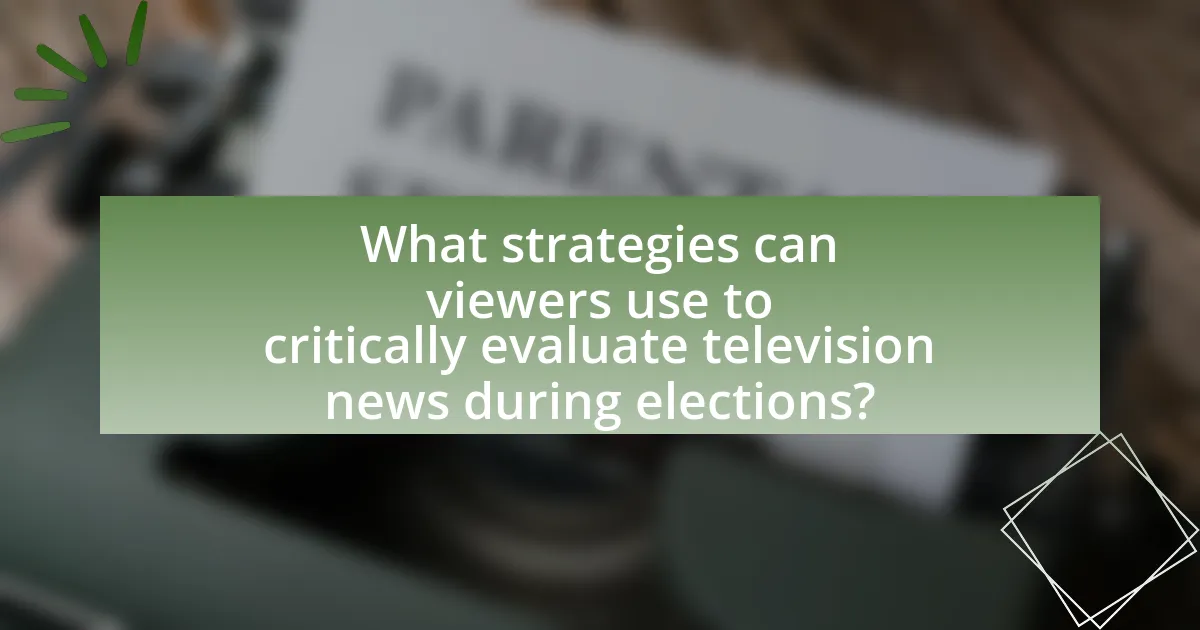
What strategies can viewers use to critically evaluate television news during elections?
Viewers can critically evaluate television news during elections by employing strategies such as cross-referencing information, analyzing the source of the news, and recognizing bias. Cross-referencing involves checking multiple news outlets to compare coverage and identify discrepancies, which helps in understanding different perspectives. Analyzing the source includes assessing the credibility of the news organization, considering its history, ownership, and potential biases, as studies show that media ownership can influence reporting (e.g., the Pew Research Center’s findings on media bias). Recognizing bias entails being aware of language and framing that may skew information, as research indicates that emotionally charged language can affect audience perception (e.g., the work of George Lakoff on framing in political discourse). These strategies empower viewers to form a more informed opinion about the political narratives presented during elections.
How can viewers identify bias in news reporting?
Viewers can identify bias in news reporting by analyzing the language, tone, and framing used in the coverage. For instance, biased reporting often employs emotionally charged language or selectively highlights certain facts while omitting others, which can skew the audience’s perception. Research indicates that news outlets may favor particular political narratives, especially during elections, by emphasizing stories that align with their editorial stance. A study by the Pew Research Center found that 62% of Americans believe news organizations tend to favor one side when reporting on political issues, illustrating the prevalence of perceived bias. By critically evaluating these elements, viewers can discern potential biases in news reporting.
What tools are available for fact-checking news stories?
Various tools are available for fact-checking news stories, including Snopes, FactCheck.org, and PolitiFact. Snopes is widely recognized for debunking urban legends and misinformation, while FactCheck.org focuses on verifying claims made by politicians and public figures. PolitiFact rates the accuracy of statements on a scale from “True” to “Pants on Fire,” providing a clear assessment of factual claims. These platforms utilize rigorous research methods and source verification to ensure the accuracy of the information they present, making them reliable resources for fact-checking in the context of news stories.
How can viewers diversify their news sources for a balanced perspective?
Viewers can diversify their news sources for a balanced perspective by actively seeking information from a variety of media outlets, including local, national, and international news organizations. This approach allows individuals to compare different viewpoints and reduces the risk of echo chambers that can distort understanding. Research indicates that consuming news from multiple sources, such as newspapers, online platforms, and broadcast media, enhances critical thinking and provides a more comprehensive view of events. For instance, a study by the Pew Research Center found that individuals who engage with diverse news sources are better informed about political issues and exhibit a greater understanding of differing perspectives.
What practices can enhance media literacy among voters?
Practices that can enhance media literacy among voters include critical evaluation of news sources, engagement in media literacy education programs, and active participation in discussions about media content. Critical evaluation involves assessing the credibility of news outlets, understanding bias, and recognizing misinformation, which is essential given that a 2020 study by the Pew Research Center found that 53% of Americans believe that news organizations intentionally mislead the public. Media literacy education programs, such as those implemented in schools, equip individuals with the skills to analyze and interpret media messages effectively. Furthermore, engaging in discussions about media content fosters a collaborative environment where voters can share insights and challenge misleading narratives, thereby strengthening their understanding of the media landscape during elections.
How can educational programs improve understanding of media influence?
Educational programs can improve understanding of media influence by providing critical media literacy skills that enable individuals to analyze and evaluate media messages effectively. These programs teach participants to recognize biases, identify persuasive techniques, and understand the impact of media framing on public perception, particularly during elections. Research indicates that media literacy education can enhance critical thinking and reduce susceptibility to misinformation, as evidenced by a study published in the Journal of Media Literacy Education, which found that students exposed to media literacy curricula demonstrated improved analytical skills and a greater ability to discern credible sources.
What role do discussions and debates play in fostering critical thinking about news?
Discussions and debates play a crucial role in fostering critical thinking about news by encouraging individuals to analyze, evaluate, and synthesize information from multiple perspectives. Engaging in discussions allows participants to confront differing viewpoints, which challenges their assumptions and promotes deeper understanding of complex issues. Research indicates that exposure to diverse opinions enhances critical thinking skills, as individuals learn to assess the credibility of sources and the validity of arguments presented. For instance, a study published in the Journal of Communication found that students who participated in structured debates demonstrated improved analytical skills and a greater ability to discern bias in news reporting. This process of critical engagement ultimately leads to more informed citizens who can navigate the complexities of political narratives shaped by television news channels during elections.
What are the best ways to stay informed without being misled?
To stay informed without being misled, individuals should critically evaluate news sources, prioritize reputable outlets, and cross-reference information. Research indicates that consuming news from diverse, credible sources reduces the risk of misinformation. For instance, a study by the Pew Research Center found that individuals who access news from multiple platforms are less likely to fall for false information. Additionally, fact-checking websites like Snopes and FactCheck.org provide verification of claims, further ensuring accuracy. Engaging in media literacy education also equips individuals with the skills to discern credible information from misleading narratives.
How can viewers develop a habit of questioning news narratives?
Viewers can develop a habit of questioning news narratives by actively engaging in critical thinking and media literacy practices. This involves analyzing the sources of information, understanding the context in which news is presented, and recognizing potential biases in reporting. Research indicates that individuals who regularly practice these skills are more likely to identify misinformation and assess the credibility of news outlets. For example, a study by the Pew Research Center found that media literacy education significantly improves individuals’ ability to discern factual reporting from opinion-based narratives. By consistently applying these techniques, viewers can cultivate a more questioning and analytical approach to news consumption.
What resources are available for learning about media literacy?
Resources available for learning about media literacy include online courses, educational websites, and books focused on critical analysis of media. For instance, the Media Literacy Now organization provides comprehensive resources and advocacy for media literacy education, while platforms like Coursera and edX offer courses from universities that cover media analysis and critical thinking. Additionally, books such as “Media Literacy: Keys to Interpreting Media Messages” by Art Silverblatt provide foundational knowledge and practical skills for understanding media content. These resources are validated by educational institutions and organizations dedicated to promoting media literacy as a vital skill in today’s information-rich environment.
